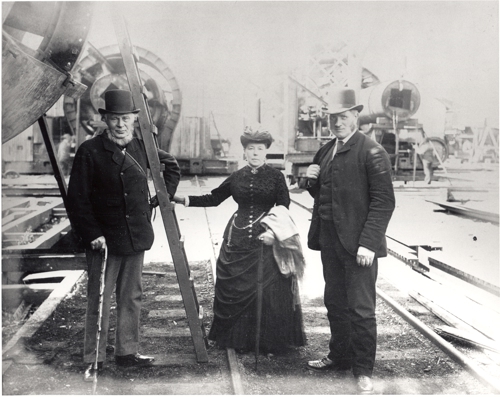Due to essential maintenance the WEST Footpath/Cycleway is CLOSED, please use the EAST Footpath/Cycleway. Both Footpaths/Cycleways open at Weekends
Access Restrictions
The Forth Bridge Builders
Designer, Engineer & Contractor
Three men stand out in the creation of the Forth Bridge: Designer Benjamin Baker, Consulting Engineer John Fowler, and Building Contractor William Arrol.
The Designer
Benjamin Baker (1840-1907) began his career at 16 as an apprentice in the Neath Abbey Ironworks. He moved to London, where he was involved in the construction of Victoria Station, and joined the firm of John Fowler in 1862, becoming a partner in 1875.

The two men were greatly involved in the creation of London’s underground railway system, which had been begun by Fowler in the early 1860s.
Baker’s other achievements included designing the vessel to carry Cleopatra’s Needle from Egypt to Britain, and acting as consulting engineer on the Aswan Dam from 1894 to 1902.
Benjamin Baker was knighted in 1890 for his work on the Forth Bridge.
The Consulting Engineer
John Fowler (1817-1898) was one of the great civil engineers of the Victorian railway boom.

He designed a number of bridges – including the Grosvenor Bridge, which carried the first railway across the Thames – and designed Victoria Station in London and stations in Glasgow, Sheffield, Liverpool and Manchester. Manchester Central Station’s 64m-wide train shed roof was the second widest unsupported steel arch in the country, after the roof of St Pancras Station.
Some of his most memorable work, though, was as a pioneering engineer on the various lines which became the London Underground.
He was also involved in engineering and railway work abroad, with projects in Algeria, Egypt, Australia, Belgium, the United States, Germany, France and Portugal.
In 1865 he became the youngest ever president of the Institution of Civil Engineers and was active in leading the development of training for engineers.
By the time he came to his work on the Forth Bridge he had passed much of the design work on to Benjamin Baker, but he remained the senior partner throughout the construction and was made a baronet on completion of the bridge in 1890.
The Contractor
William Arrol (1839-1913) was the classic Victorian ideal of the self-made man, rising from humble origins to fame and a knighthood through hard work and ingenuity.

Beginning work in a cotton mill at the tender age of nine, he became a blacksmith’s apprentice at 14. He joined a Glasgow firm of builders and bridge makers in 1863 and just five years later was able to launch his own business on his life savings of £85.
He established his Dalmarnock Works in 1872 and within three years built his first major bridge, taking the North British Railway across the Clyde at Bothwell.
He won the contract to build Bouch’s planned suspension bridge across the Forth and, when that was halted, he won the contract for the successful Baker and Fowler design.
In a work schedule which didn’t ease with success, he was also the contractor for the new Tay Rail Bridge, and a typical week would see him spend Monday morning at his works at Dalmarnock before going for two days to the Forth, two days to the Tay and one back at Dalmarnock – before getting on the train to London to consult with Fowler and Baker on the Saturday and sometimes the Sunday too.
By the time he was knighted for his work in 1890, he had already started work on London’s Tower Bridge (opened 1894) and future contracts would include the Wear Bridge at Sunderland and the Nile Bridge at Cairo.
The Briggers
The 'Briggers' is the name given to the men and boys who toiled in perilous conditions to construct the bridge. Read more about the building of the bridge here.


